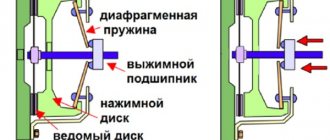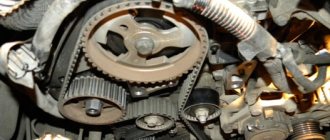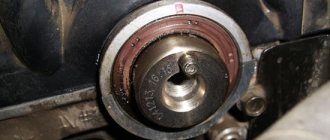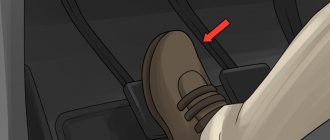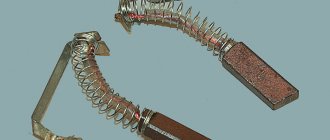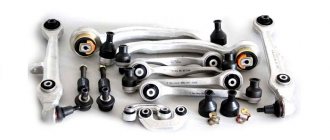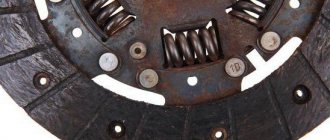As a result of constant use of the car, various breakdowns may occur. They fall into two main categories: clutch failure and drive wear. The following describes the symptoms of each problem and its solution.
Main external signs of clutch failure
- The clutch moves or, conversely, slips
- There are jerks in place
- Car interior vibrates when clutch is engaged
- There are noises when driving
Signs of a faulty release bearing:
There are a number of reasons for malfunctions, the most common of which are:
- Incorrect operation of the machine. Here, among other things, they include a sharp start to movement with high acceleration and constantly keeping your foot on the pedal while moving.
- Expiration of the term of use.
- Driven disk wear. It is worth noting that this part, when used correctly, lasts up to a mileage of 100 km, but if the car is not handled carefully and driven at high speeds, the disc will wear out after 30-40 km.
- Installation of non-original parts or parts of poor quality.
- Friction linings are dirty. The reason for this most often is engine oil getting on this part or damage to the seals (engine or gearbox).
As a result of the initial inspection, it is not possible to diagnose the problem with absolute accuracy, since one symptom may indicate several malfunctions at once. Therefore, it is recommended to completely disassemble the mechanism to more accurately determine the problem.
The most common types of clutch failures:
- The heavy disc linings are worn out and out of order
- The disk basket is damaged due to use
- Disc linings are dirty
- The driven disk has become unusable
- Springs have lost their elasticity
- The diaphragm spring has burst or weakened
- The pressure bearing has burst or worn out
- The flywheel has become unusable
- The fork started to jam
If it is difficult to change gears while driving, a strange noise or crackling noise is heard while driving, and the pedal travel increases, then the problem is most likely a clutch malfunction.
If there is a burning smell when shifting the clutch, the car is driven, the engine quickly overheats and gasoline is consumed faster, this means that the clutch is slipping.
If the car moves jerkily even when driving softly, then the release bearing is to blame. Most likely, it has worn out: the bearing has become deformed.
The pressure plate may become unusable if the basket malfunctions.
Clutch operating principle
The clutch is responsible for transmitting torque from the engine to the gearbox. Its main task is to disconnect the units at the moment of switching speed. It is worth noting that this mechanism is different on cars with automatic and manual transmissions. On engines with a robotic transmission, the interaction with the engine is slightly different, and its functions are controlled electronically.
If we omit all the nuances, the clutch consists of the following components:
- The drive connects the pedal and the clutch itself (there are several options: mechanical, with a cable and hydraulic). On a robotic transmission, the drive is activated by an actuator, which receives commands from the ECU.
- Basket. Consists of a release bearing and a pressure plate.
- Driven disk.
- Fork.
- Damper springs.
- Control pedals.
When you press the pedal, force is transmitted to the clutch fork via a cable or hydraulic cylinder. The fork, through the release bearing, mechanically acts on the petals of the pressure plate, which, under the influence of this force, bends towards the flywheel. This causes the driven and driven discs to lose traction and the engine to idle without any load on the wheels.
Replacement
The procedure is not so simple, therefore, if you lack experience, it is not recommended to do it yourself. If you have enough skills and abilities, get to work.
- Disconnect the clamps and remove the release bearing along with the clutch.
- Remove the input shaft from the bearing.
- After fully releasing the clamps, remove the damaged bearing from the coupling.
- Install a new part, but first make sure of its quality. If the bearing moves freely, there is no need to worry, it works well.
- Lubricate the clutch and the release tool itself. This device loves high-quality lubrication. Then install it on a release sleeve that has been pre-treated with machine oil.
- Using special clamps, place the new element in its rightful place.
- The final stage will be reassembling and installing the gearbox in its original position.
The work can be considered completed. It is quite possible to do it yourself, but just do not forget about the accuracy and consistency of your actions.
A high-quality squeezer lasts a long time, so you won’t have to perform such operations regularly. Of course, provided that you have correctly replaced the old bearing and your clutch is functioning efficiently.
https://youtube.com/watch?v=d1bb0mbPPsA
Signs of clutch problems
Often drivers, especially new car owners, when problems arise with the clutch, realize that the car has begun to behave differently, but continue to drive without making any attempts to find out what the reason is. As a result, this leads to serious damage and the car completely fails. Knowing the main symptoms of a clutch malfunction, you can take timely measures - carry out repairs yourself or contact service center technicians or service stations.
Below are the main symptoms of clutch malfunctions and which unit is responsible for this or that atypical behavior.
Incomplete clutch release
Among motorists - “the car is driving.” In other words, when the clutch lever is pressed, the driven disc is partially disconnected from the motor wire shaft. This leads to the fact that the car begins to twitch at the beginning of the movement at the moment of changing gear, even though the pedal is depressed smoothly, as usual.
What causes this problem to occur:
- Small pedal free play. It may be different for each car; you should look for information in the technical data sheet.
- The drive is poorly adjusted. On mechanical and hydraulic drives, the defect is eliminated in different ways.
- Clutch disc deformation. This happens more often when the axial runout value is greater than 0.5 mm. Under such circumstances, the friction lining of the disk bends and presses it against the flywheel of the internal combustion engine.
- Clutch disc wedge in shaft grooves. A common reason is parking the car for long periods of time, especially outdoors.
That is, it is not so easy to determine exactly what led to the clutch failure, because one defect may be the result of damage to one or more elements.
If after adjustment the defect has not been eliminated, the only option is to replace the clutch with a kit. Always change the clutch as a set (disc, basket, release) since saving on spare parts usually leads to repeated disassembly, loss of time and money.
Clutch slipping
The main signs indicating a malfunction of the clutch are the following: pressing the gas pedal almost all the way with the clutch released, the engine “growls”, but the car does not react or the reaction is very weak. In addition, you can hear a characteristic burning smell from the engine compartment, this is due to the clutch disc slipping and, as a result, its heating.
Causes of malfunction:
- The free play of the clutch pedal is out of adjustment (a very rare reason).
- Oil contamination of the friction lining of the driven disc. More common in cars with high mileage. Possible wear of the oil seal or gasket, insufficient joint tightness, etc. can lead to lubricant splashing and getting onto the friction linings (which leads to the smell of burning oil).
- The friction lining is worn.
- Drive faults. Help will be needed to determine this. Looking under the bottom of the car, ask an assistant to depress the clutch pedal. The rod of a working cylinder moves, pushing the fork. Otherwise the drive is damaged.
On a hydraulic drive, the problem may be caused by a clogged compensation hole in the main cylinder.
Almost always eliminated by replacing the clutch with a kit.
The occurrence of atypical noise when depressing the clutch pedal
When the pedal is released there is no extraneous sound. When pressed, a characteristic rustling sound appears, intermittent grinding of different levels and similar noises.
Causes of malfunction:
- The appearance of a gap or insufficient amount of lubrication led to the release bearing crumbling.
- Damper springs or basket petals have failed.
- The driven shaft bearing in the transmission is worn out.
If the release bearing wears out, you can only replace it, BUT only if you are sure that all other clutch elements are in excellent condition. Agree, it will be a shame to remove the box again in a month to replace the disk or basket.
The clutch pedal makes a squeaking sound and does not move back
In this case, you should try to move it to its original position with the toe of your shoe. If this does not help and the squeak remains, most likely the drive is jammed. A loose release bearing may also be the cause. Less commonly, the consequence of such a defect is the jamming of the clutch lever spring (for example, after a long period of inactivity) or the master cylinder rod.
In addition, the bushing on the rod at the place where the pedal is fixed can produce a squeak. In this case, it is enough to lubricate it.
The clutch disengages when the pedal is pressed hard
And when you press or release smoothly, the clutch does not engage. This is a symptom of a faulty hydraulic drive. There are several reasons for its failure:
- depressurization of the transmission system line;
- low fluid level in the system;
- Excessive wear of the master cylinder cuffs.
Car jerks when using the clutch pedal
If the drive is working properly, the reason may be caused by loosening of the friction linings or their wear. In this case, they will need to be replaced.
Insufficient effort when pressing the clutch pedal
More often, low pedal resistance is caused by air in the clutch hydraulic system. You can fix it by removing air - bleeding the system.
When to change and how to check the clutch - its service life may have come to an end
Good day, dear car enthusiasts! Each of us is always concerned about how long this or that part or car system will last. It `s naturally. Especially considering the quality of some products, the “skills” of workers, etc.
This issue fully concerns the car’s clutch. Very often on motorist forums there is a serious question about when to change the clutch, and how to know when the time has come to replace it. So let’s try to figure out together what the actual service life of the clutch is, and whether it exists at all.
Diagnosis of clutch faults
You can check the performance of the coupling using simple and reliable folk methods. Naturally, we are not talking about disassembling the entire mechanism, but about how to independently check the clutch and, based on the data, make a decision about the need for in-depth diagnostics followed by dismantling.
"Drives" the clutch
In the case when the discs do not completely separate when pressing the clutch pedal, the clutch is said to have “engaged”. This means that they have some kind of contact, so the clutch is not completely turned off. Experienced car owners know how to check the mechanism for complete shutdown.
Diagnosis is quite simple. To do this, at low speeds with the pedal fully depressed, first gear is engaged. If such an action was carried out easily and was not accompanied by extraneous noise, the shutdown occurred completely. In case of difficulty in switching, which additionally caused gear noise, it means “drives”.
To eliminate the causes you will need:
- adjust the drive;
- clean and lubricate the splines;
- repair or replace the driven disk;
- replacing friction linings.
Any mechanism has to be changed sooner or later. In a hydraulically driven system, you will need to pump it to remove any accidentally trapped air, check the tightness of the connections and the integrity of the pipes. If necessary, replace parts that have failed (for example, the main or working cylinder in case of a fluid leak).
Clutch “slips”
If while driving you heard the smell of burnt oil, and on uphill slopes the car began to noticeably lose speed, and in general the dynamics deteriorated significantly, then no diagnostics are needed. Verdict - the clutch is slipping.
This indicates that the drive and driven disks do not mesh tightly enough when turned on. There is one very simple and accessible way to check the operation of the mechanism. To do this you will need:
- put the car on the handbrake and start the engine;
- Depress the clutch pedal and engage gear;
- smoothly press the gas pedal and then also smoothly release the clutch.
The engine should stall. Otherwise, the clutch slips. Defects can be eliminated by adjusting the drive and replacing the linings. Rubbing parts that have been exposed to oil should be thoroughly cleaned with a solvent (for example, white spirit). Then determine the reason for the lubricant getting into the mechanism and eliminate it.
Checking clutch wear
Checking the degree of wear of the driven disc is also a fairly simple task, which will tell you whether it is time to change the clutch or not. To do this, you need to start the engine and engage first gear. Then try to move away without accelerating. This will help you understand the condition of the clutch disc:
- the clutch “grabs” at the very beginning - the disc is in excellent condition, the mechanism is fully operational;
- The clutch “suffices” approximately in the middle - the disc is worn out by half or needs adjustment;
- The clutch “grabs” only at the end of the pedal stroke - the disc must be replaced.
In some cases, the disc is not yet completely worn out, and normal clutch operation is restored by simply adjusting the appropriate nuts.
Examination
To make sure that the clutch really needs to be replaced with a clutch releaser on a VAZ 2114, it is first recommended to check it thoroughly for malfunctions. This will allow you to determine whether this device is really the cause of the problem.
The bearing allows the disc to disengage from the basket, plus it additionally ensures that the clutch is engaged and disengaged.
There are two types of squeezers:
- Roller. They work on the basis of a rigid bunch of rods.
- Hydraulic. The hydraulic system ensures power transmission.
Even an inexperienced car owner can detect a faulty release bearing. The failure of this element manifests itself as follows:
- When moving, extraneous sounds and noises arise;
- Gear shifting is difficult;
- When overtaking, the clutch may completely disappear;
- Slippage occurs during acceleration, etc.
If the squeezer turns out to be truly faulty, it is the responsibility of every car owner to replace it immediately. This can be done with the help of service station technicians, or with your own hands.
Other signs of clutch failure
When the friction linings wear critically, the behavior of the car changes significantly. The following are signs of a burnt coupling:
- It is difficult to start moving. The car can remain stationary even when the clutch pedal is fully released. This means that the disc is not pressed enough to transmit torque to the transmission. Here you can judge the critical wear of the driven disk.
- Car jerking while driving. In this case, you can still start moving, but the start will create discomfort - the car jerks strongly. When the speed increases, the jerking disappears. However, the next time you try to drive from first gear, the jerking and vibration will appear again. In addition, the car may accelerate atypically when switching to higher speeds. Since the disk is not pressed tightly enough to the flywheel, the torque is transmitted intermittently. The car loses acceleration dynamics. If you disassemble the coupling, you can see the play of the diaphragm springs. They are responsible for compensating and smoothing the loads coming from the flywheel to the transmission. If such play is detected, the mechanism must be replaced.
- Free play of the clutch pedal.
Based on these signs, you can judge whether the clutch is faulty without additional diagnostics. However, to get the full picture, it is better to contact specialists.
After we have decided on troubleshooting, it’s time to choose the best clutch kit for your car, our rating.
The most common causes of clutch system failure
The human factor can lead to premature failure of a given unit. Here are several factors that affect clutch life reduction:
- Aggressive driving style. You should not constantly press and release the clutch pedal sharply - this will cause the friction linings to quickly fail.
- Driving under increased loads.
- Incorrect towing. Inexperienced car owners often keep the pedal half-pressed when towing. It is also not recommended to tow vehicles much heavier than your car.
- Driving with the clutch pedal half depressed.
- Sharp starts and too smooth at high speeds.
- Many beginners often keep the clutch depressed during short stops (for example, at a traffic light). This should not be done, since in this position the release bearing is under constant load, and this leads to its premature failure.
The working life of the coupling is quite long and ranges from 100 to 150 thousand km. When used correctly, the mechanism is quite reliable and reaching the top level is quite possible.
